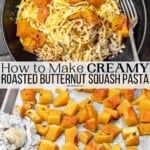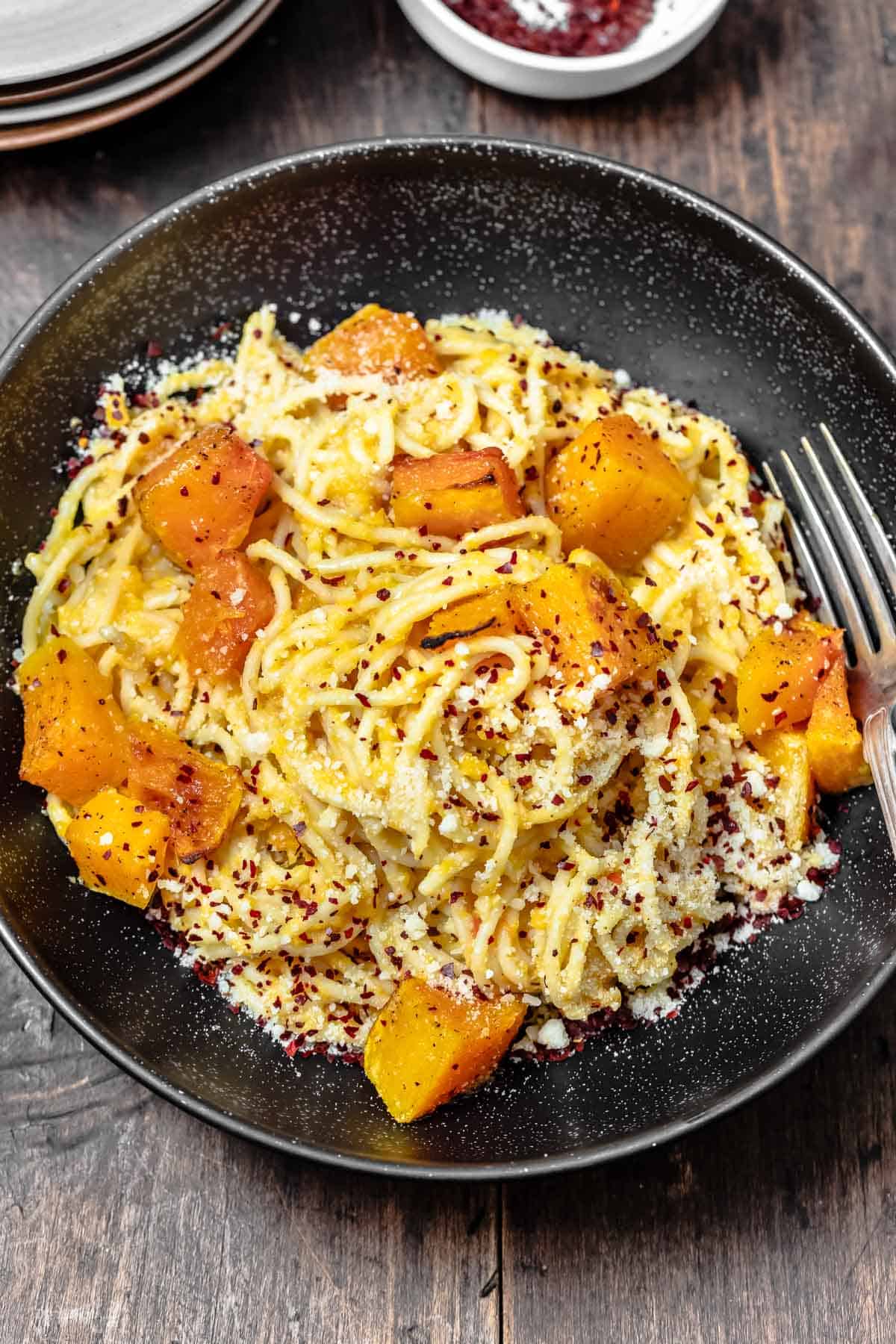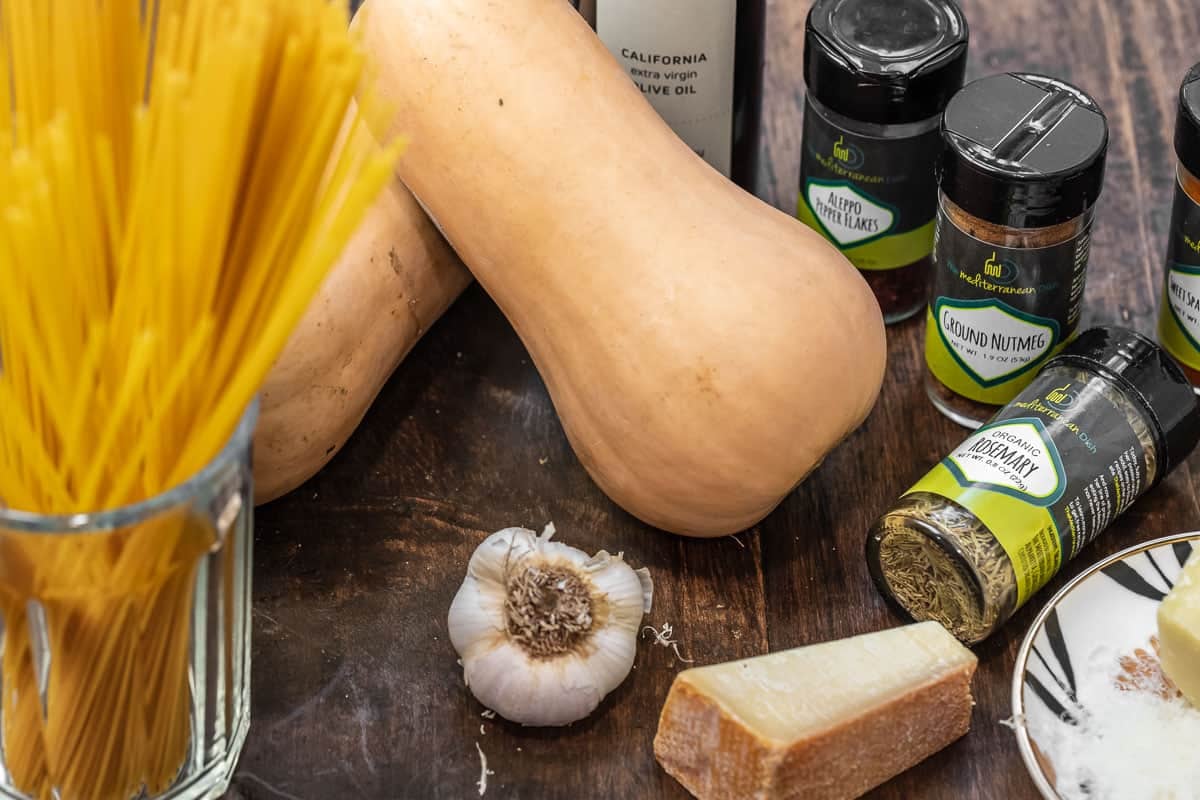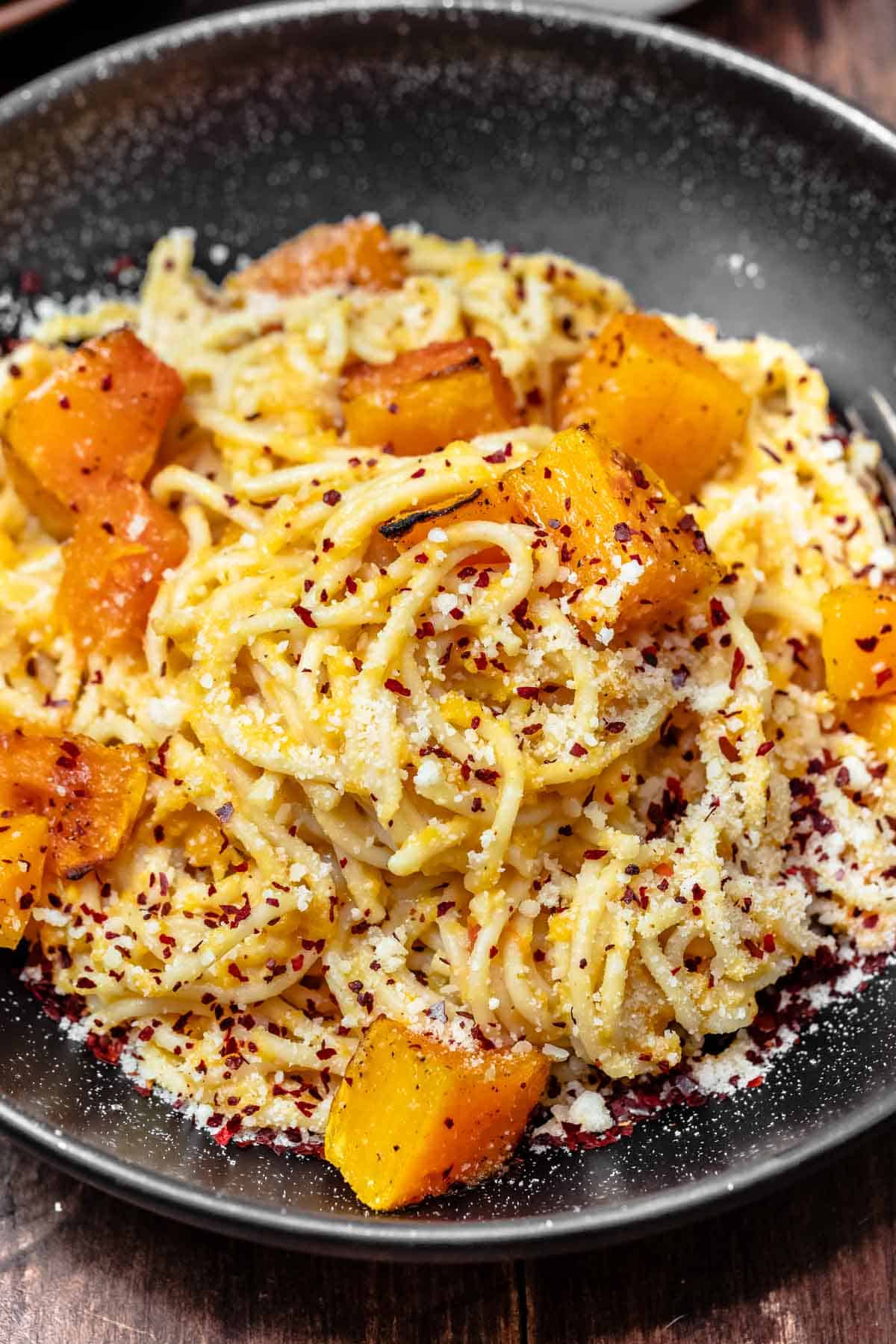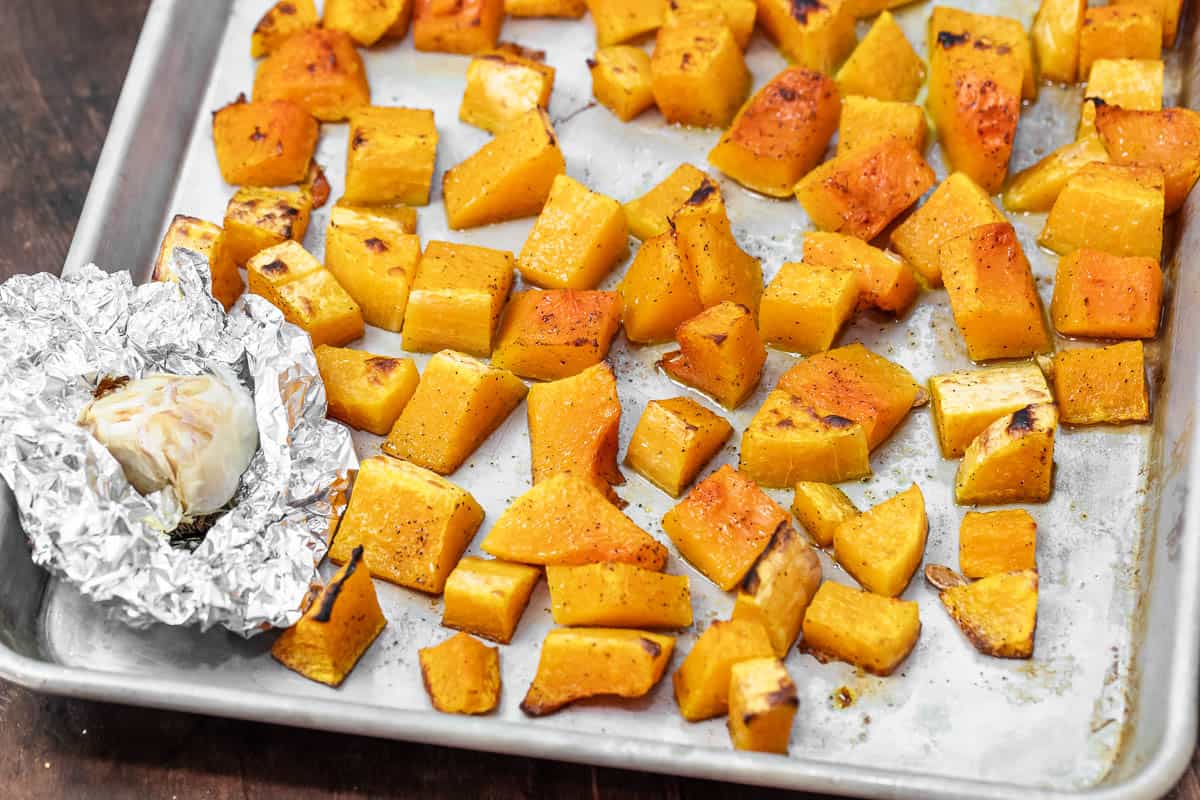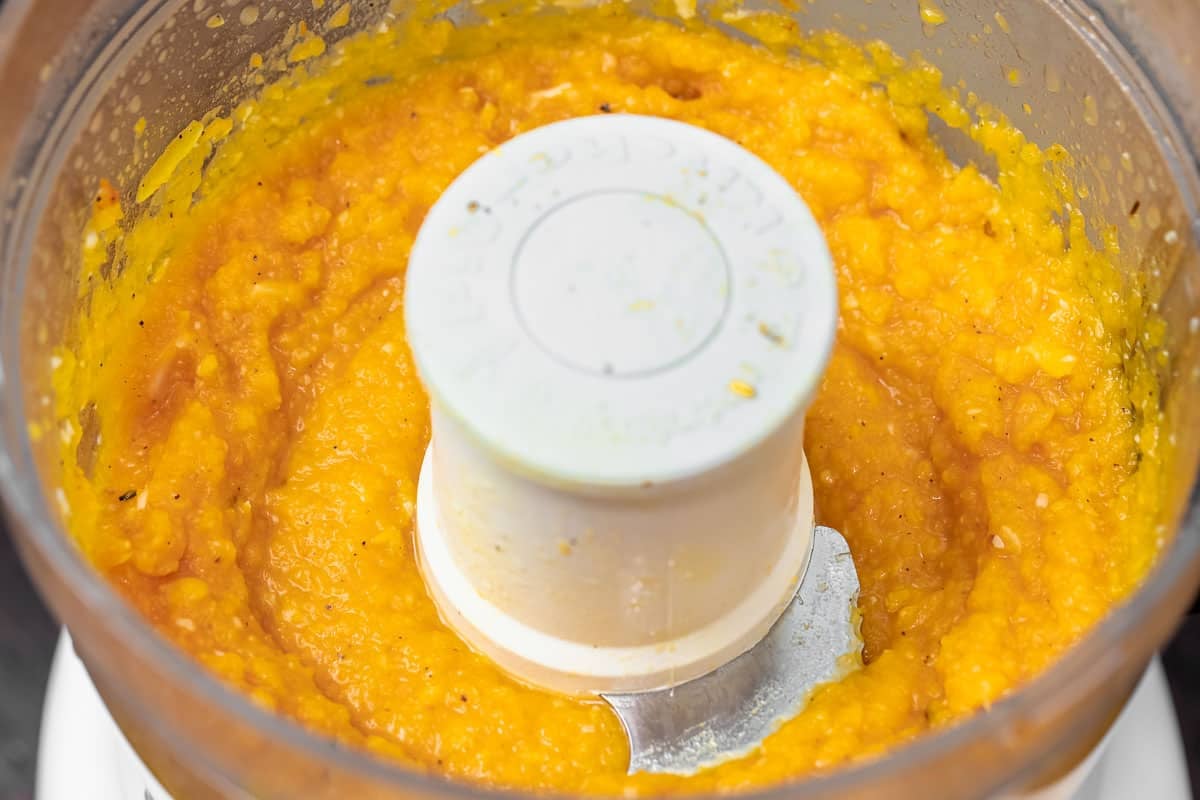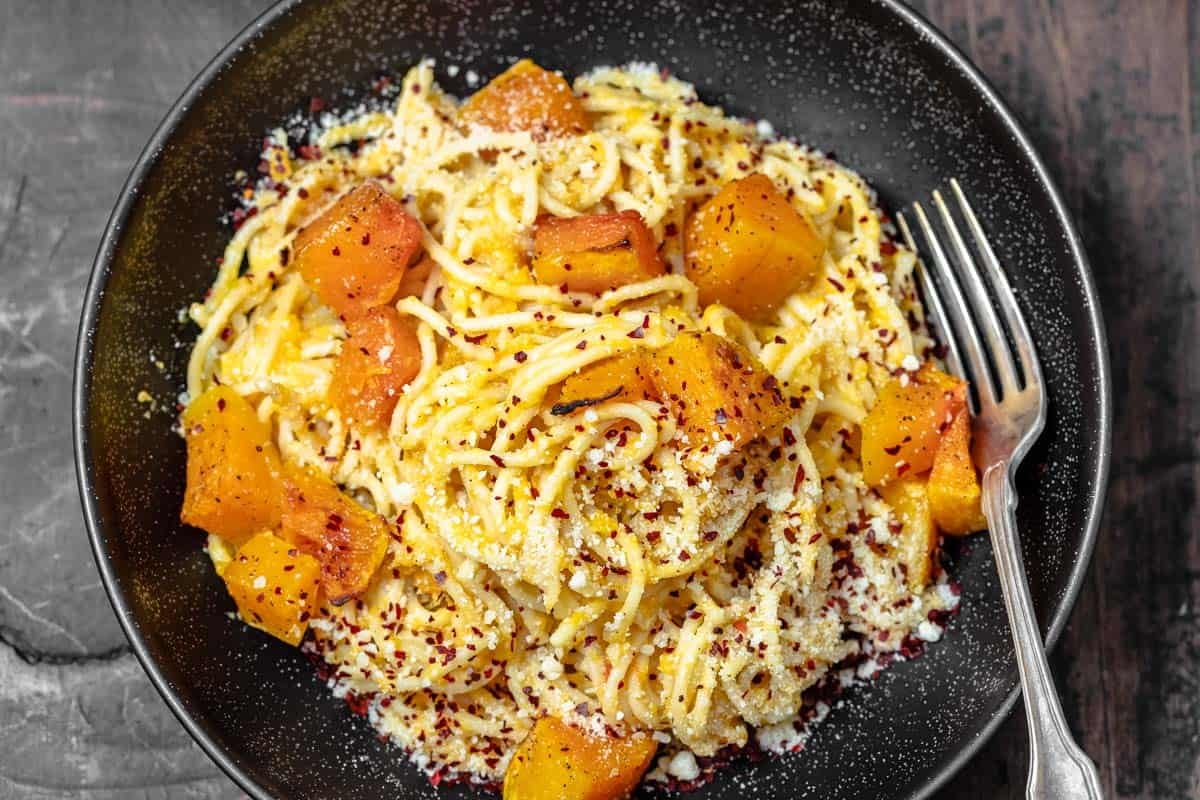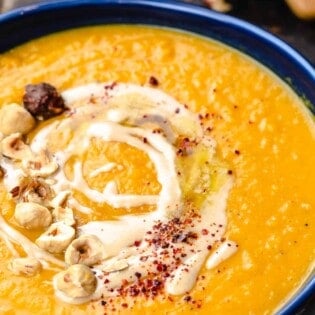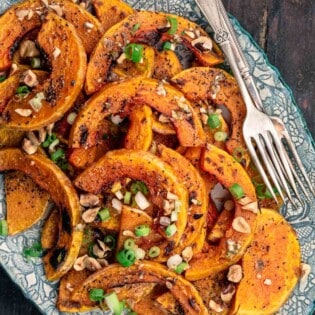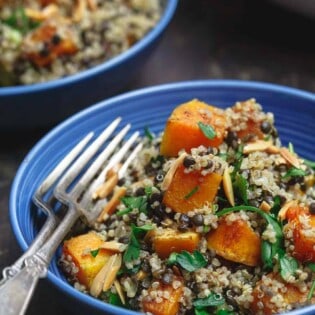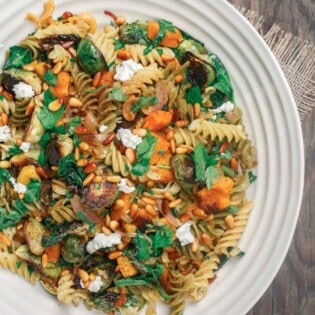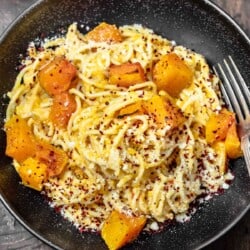Butternut squash lovers, this one’s for you — a must-try vegetarian butternut squash pasta! Tender, caramelized roasted butternut squash is blended with a whole head of roasted garlic to make a creamy, beautiful, flavor-rich sauce without the cream. A little cheese, a few earthy spices like nutmeg and paprika, and you have yourself a swoon-worthy pasta dinner, with a taste of fall in every bite. Make it a feast by adding a my shaved Brussels sprouts salad. It’s easy to make and has sweet apples, salty feta, and a little crunch from the nuts. When served alongside this butternut squash pasta you’ll have a colorful table bursting with all your favorite fall flavors. As you know we eat with our eyes first and there is nothing wrong with cooking for the sake of taste, health, and beauty!
How to make butternut squash pasta sauce
There are two secret ingredients to making a creamy, rich pasta sauce without the cream:
Your food processorPasta cooking water
Pureeing vegetables to make creamy soups and sauces is under appreciated if you ask me. Give the squash a quick whiz in the food processor or blender and your veggies become sauce-worthy! Roasting the butternut squash first gives it those warm rich flavor notes from being caramelized in the oven — roasting vegetables makes everything you add them to taste better. When you puree it all together it provides a noticeably more complex flavor profile for your pasta sauce.Pasta cooking water is basically magic. A few tablespoons of the starchy liquid can transform a sturdy pasta sauce into a velvety blanket coating your favorite noodles so you’re sure to get a fall flavor experience with every bite. If your sauce is too thick, just add a little pasta water until it reaches the consistency you desire.
How to peel butternut squash
If I were simply roasting butternut squash to eat as a healthy side dish, I’d leave the skin on — it’s edible and becomes so crispy when roasted. However, we want a smooth sauce in this recipe, so it’s best to peel the squash before you cut it. Here’s how:
Trim both ends of the butternut with a sharp knife so you end up with two flat surfaces. This gives you a stable, safe surface to work with. Stand the squash up on one of its cut sides. I like placing the larger flat side on my cutting board.Hold the butternut squash in your non-dominant hand and using a vegetable peeler pull downward until all the peel is off.Your butternut squash is now ready to cut and seed!
How to cut and seed butternut squash
There isn’t one right way to cut a butternut squash. In my roasted butternut squash with lime and hazelnut recipe, I cut it into slices that resemble half-moons. For this recipe, I went with cubes instead. Here’s how to do that:
After peeling the squash, keep it standing up and grab your sharp chef’s knife once again. Carefully cut the squash down the middle. You will end up with two long halves. To seed the butternut squash, simply scoop the seeds out with a spoon. (Butternut squash seeds are edible, so you can clean and toast them separately. If you’d rather not, throw them out. Turn the halves over so the cut side faces down and cut the squash into sections, then 1-inch cubes.
How to make butternut squash pasta
This recipe takes a little time, but it’s so easy! Simply roast butternut squash and a full bulb of garlic, puree them, add spices and cheese, toss it with cooked pasta, and you’re done! Here’s more detail about how to make this healthy, creamy pasta dish: Read our guide for How to Roast Garlic! Learn three ways to roast garlic to add depth and flavor to any Mediterranean meal.
Prepare the butternut squash: Place the cubed butternut squash on a large sheet pan and season with kosher salt and black pepper. Add 3 tablespoons extra virgin olive oil. (I like to use my spicy, peppery Early Harvest Greek EVOO. Its robust flavor complements the sweetness of the squash in this recipe.) Toss so the squash is well coated. Spread the squash so it’s in a single layer on the sheet pan.Prepare the garlic: Next, work on your garlic. Peel away any loose papery skin, but don’t peel it all the way as you still want the head to be intact (no loose cloves). Slice about 1/4 to 1/2-inch off the top so the cloves are exposed. Place the head of garlic, cut side up, in a piece of foil big enough to encase it. Drizzle 1 tablespoon EVOO over the exposed garlic cloves before wrapping it in the foil. Place the garlic on the sheet pan with the butternut squash. (If you want to learn more about the ins and outs of roasting garlic, check out our guide on How to Roast Garlic.)Roast the garlic and butternut squash. Place the sheet pan on the center rack of an oven heated to 425°F. Roast for about 30 minutes or so, checking halfway to turn the squash. The butternut squash is ready when it is very tender. Both the squash and the garlic should be slightly charred in some parts as well.Cook the pasta. While the squash and garlic roast, cook 1 pound of spaghetti or linguine to al dente by adding it to a pot of salted boiling water. When the pasta is ready, save about 1 1/2 cups of the pasta cooking water before draining. Don’t wash the pasta cooking pot — you’ll need it later. Just set it on the stove for now while the pasta drains in a colander. Puree the butternut squash. Remove the roasted squash and garlic from the oven. Reserve 1 1/2 cups cubed butternut and set it aside for now. Place the rest of the squash in a large bowl of a food processor and squeeze the garlic out of its papery skin, add it to the squash. Add a generous drizzle of extra virgin olive oil. Close the lid of the food processor and pulse a few times. While you do that, pour 2 tablespoons of the pasta cooking water from the top opening until the squash is pureed to a smooth and creamy consistency. If the puree is too thick for your liking, keep adding the pasta water a tablespoon at a time until you get the consistency you want.Make the pasta sauce. Spoon the pureed squash and garlic into the pasta cooking pot. Add 1/2 teaspoon each rosemary, nutmeg, and paprika, as well as 1/2 cup each Pecorino Romano and gruyere cheese. Cook over medium-low, stirring regularly. If you need to thin out the sauce, add a little pasta cooking water or some extra virgin olive oil until the cheese is melted and the sauce is creamy.Finish and serve: Add the pasta to the sauce. Stir to combine and finish with more cheese if you like. Stir in the reserved roasted squash pieces and serve.
Butternut squash pasta loves company
I recommended my shaved Brussels sprouts salad at the beginning of this story, but if sprouts aren’t your thing, then try my fennel orange salad. It’s a little more delicate than the Brussels sprouts salad, but just as beautiful and utterly delicious. If you’re pressed for time, just keep it simple and serve the butternut squash pasta with a crusty loaf of bread drizzled with our Early Harvest Greek Extra Virgin Olive Oil. I prefer this oil because it has a mild peppery heat and a nutty finish, which just goes so well drizzled over bread and eaten with pasta. Above all remember eating the Mediterranean way is about joy. You shouldn’t stress about dinner! Do what works for you.This pasta recipe is so loaded with vegetables between a whole butternut squash and a whole head of garlic, I might be inclined to enjoy a little dessert when it’s over. My favorite way to end a meal is with something sweet like these chocolate covered dates.
Variations on butternut squash pasta
The great thing about simple recipes is they are easy to adapt. Make it vegetarian as I have here or make it vegan and leave out the cheese. Or, if you’d like to add salty, smoky flavors, add a little pork. To add a little meat to this dish follow the tips below:
Chop up and toss some cooked bacon or prosciutto into the pot along with the chunks of butternut at the very end. Roast the prosciutto on the sheet pan right along with the squash to create crispy bits, but make sure you transfer it to a plate before you puree the squash! Check the oven at the 15-minute mark. The prosciutto will crisp faster than the squash will roast.
How to store and reheat leftovers
It’s best to store the sauce and noodles separate. If you think you’ll have leftovers just combine the amount of sauce and noodles you’ll eat in one setting. Then store each separately in the refrigerator for up to 4 days. To freeze leftover butternut squash pasta sauce: simply store it in a freezer-safe container for up to 6 months.
More butternut squash recipes
Browse all Mediterranean recipes.Visit Our Shop.
Creamy Roasted Butternut Squash Soup With Tahini and Hazelnut
Simple Roasted Butternut Squash with Lime and Hazelnut
Easy Butternut Squash Recipe with Lentils and Quinoa
Fall Rotini Pasta Recipe with Butternut Squash and Brussels Sprouts

